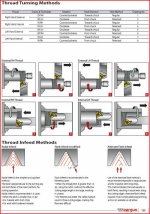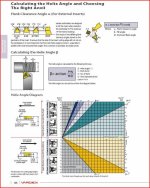OK, guys and gals, heres the deal about high RPM threading on a manual lathe. You can use proper geometry HSS threading tools, either hand ground or in insert form and get good barrel threads at about 80-140 RPM. You can get good threads with a carbide insert tool but to get great finish it takes about 250-350 on most applications, OK??
If you crash the tool into the shoulder, or worse, into the chuck, your little ChiCom lathe at those speeds, the repair will be about equal to buying a new lathe. Most of those, or any small tool room size lathe for that matter you will suffer more damage than several barrels cost!!! Plus, you might injure yourself in the meantime. If you think it is worth it have at it, just don't just come running back to the forum with a sad story!!
I taught Machine Tool Technology (fancy college name for Machinist) for 10 years and I pretty much know what a just-in-training person is capable of and it ain't threading at 300+ RPM



